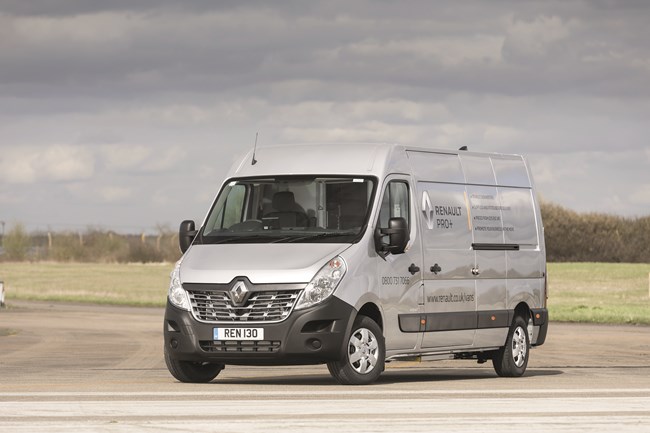- Northgate launches micromobility service
- Progress being made on shared EV charging, AFP reports
- Medisort electrifying van fleet with Bedeo
- ADVERTISEMENT FEATURE: Taking a shortcut to reduce commercial vehicle emissions
- The What Van? Road Test: Ford Ranger Raptor
- Speakers announced for Commercial Vehicle Show
- Check new vehicle registration details are correct, AFP tells fleets
- New Market Analysis: Large Vans
- Increasing proportion of leased vehicles now LCVs, BVRLA reports
- Enterprise announces commercial vehicle technician recruitment programme
Buying a used... Renault Master (2010)
Date: Wednesday, February 23, 2022 | Author: Ian Shaw
The Master has been offered in Vauxhall and Nissan flavours but its original French recipe is the best.

The Renault Master first appeared in 1980 boasting huge load volumes housed in a quirky egg-box design. The 1997 Gen-2 model was given not only a more conventional appearance, but a split personality. It was also sold as the Opel and Vauxhall Movano, giving Renault and its new found partners a three-pronged attack on the European 3.5t class to rival the Citroen / Peugeot / Fiat conglomerate of Sevel. This Mk2 version of the Master lasted until 2010 before the Mk3 version appeared with a facelift eight years in.
In this class of van, you cannot afford to offer a more limited range than your competitors. When your competitors include the Ford Transit and Citroen Relay, then you need to be at the top of your game. Renault offered the Master in four overall lengths, of 5.04m, 5.54m, 6.2m and 6.8m giving generous load lengths of 2.6m, 3.1m 3.7m and 4.4m. The full load width in all cases being 1.76m with 1.38 metres between the rear wheel arches in front-drive versions, narrowing to 1.08m for the rear-drive twin-wheel configurations. Three internal heights are on offer from 1.7m through 1.9m to 2.1m and these are not wholly interchangeable on length options. The L1 can only be had with H1 and H2 likewise L4 comes in H2 or H3 guise. Although ‘packaged’ thus, load volume options are still numerous, ranging from 7.8m3, through 8.6, 10.8, 12.3, 13.0, and 14.8, to a whopping 17m3. GVMs are 2.8, 3.3, 3.5 and 4.5t with payloads starting from a modest 920kgs in the 2.8-tonner, with up to 1,620 kgs being carried in the short, low-roof front drive 3.5-tonner and nominal 1,200 to 1,500kgs payloads up for grabs through the various length and height combinations at 3.5t. The rear-drive 4.5-tonner can boast 2,140kgs at best.
Engine options are far less complex, there’s just one. The 2.3l four-cylinder common-rail turbo diesel has served Renault well. In 2010 it began with a 100-150bhp range but backed by impressive torque.
By the 2019 facelift it had developed into the, by then, commonplace BiTurbo design, offering four outputs from 130 to 180hp, depending upon model and driven axle choice. With all but the lowest powered single turbo unit the Master drives well in urban traffic or motorway mega-miles alike. It has an excellent torque spread, well-judged gear ratio spacing and a lofty final drive make for relaxed and economical progress. The six-speed manual can be supplanted by the automated transmission at mid-bhp levels, but
it’s not the best – neither as swift-shifting nor as intuitive as a VW DSG for instance.
The cab is one of the best in its class. There are numerous storage compartments, door bins hold two-litre bottles, the twin-passenger seat squab lifts up to provide a large hidden storage space and the driving position is simply first-rate. Its name is deserved.
Five best options
1) 2.3 high output engine
2) Manual transmission
3) L3 H2 version
4) 4.5t high payload version
5) Rear drive if towing
Five best avoided
1) 100 hp engine
2) Automatic transmission
3) Shortest length
4) Low roof
5) Rear drive at lowest GVM
Second-hand buys
|
Version |
Plate |
Year |
Mileage |
Price ex.VAT |
|
2.3 dCi L2H2 |
17 |
2017 |
54,000 |
£13,995 |
|
2.3 dCi L3H2 |
18 |
2018 |
92,500 |
£14,995 |
|
2.3 dCi L2H2 |
19 |
2019 |
97,000 |
£14,000 |
|
2.3 dCi L2H2 |
20 |
2020 |
36,000 |
£19,995 |
|
2.3 dCi L1H2 |
70 |
2021 |
23,000 |
£23,975 |
View The WhatVan Digital Edition


